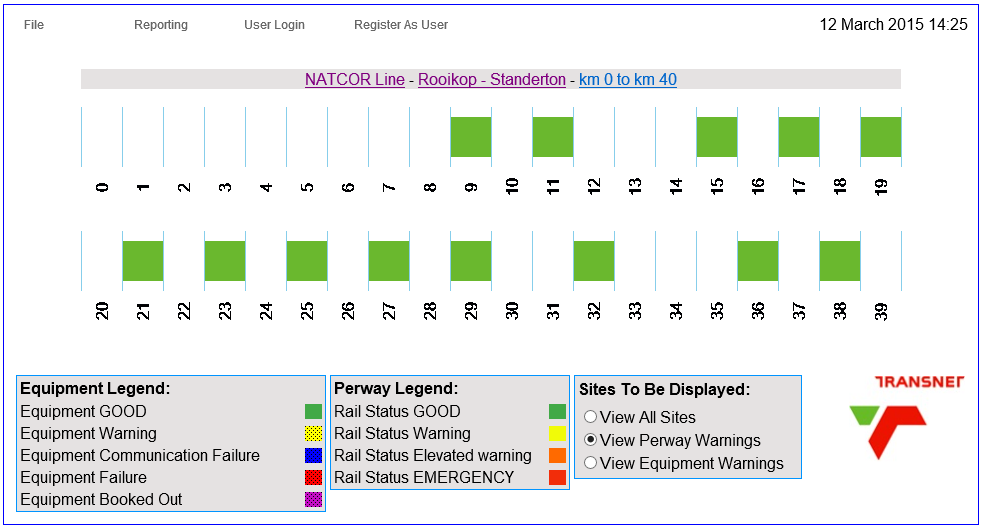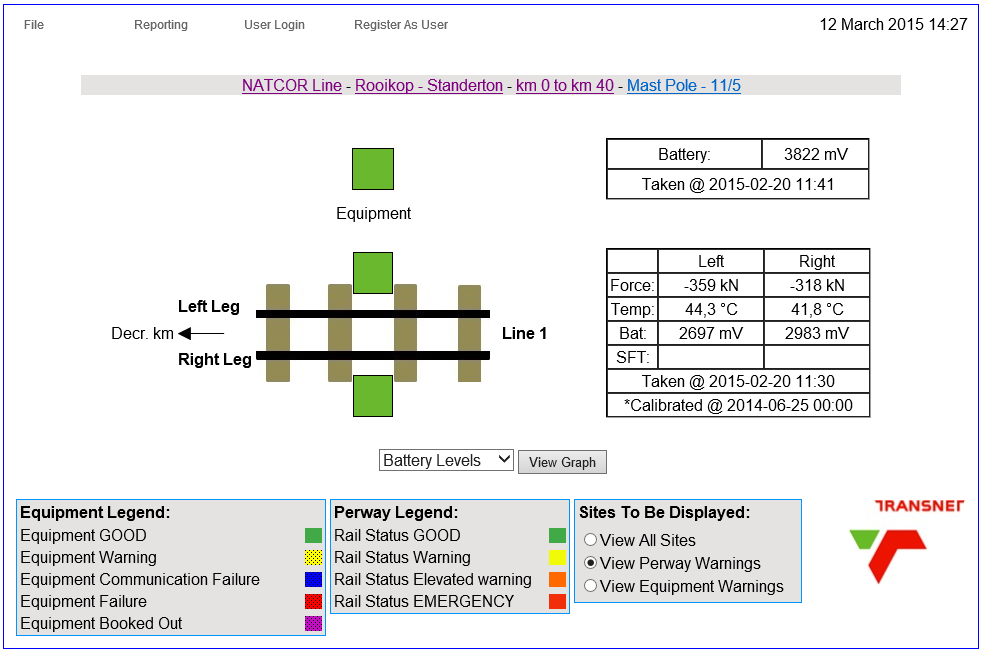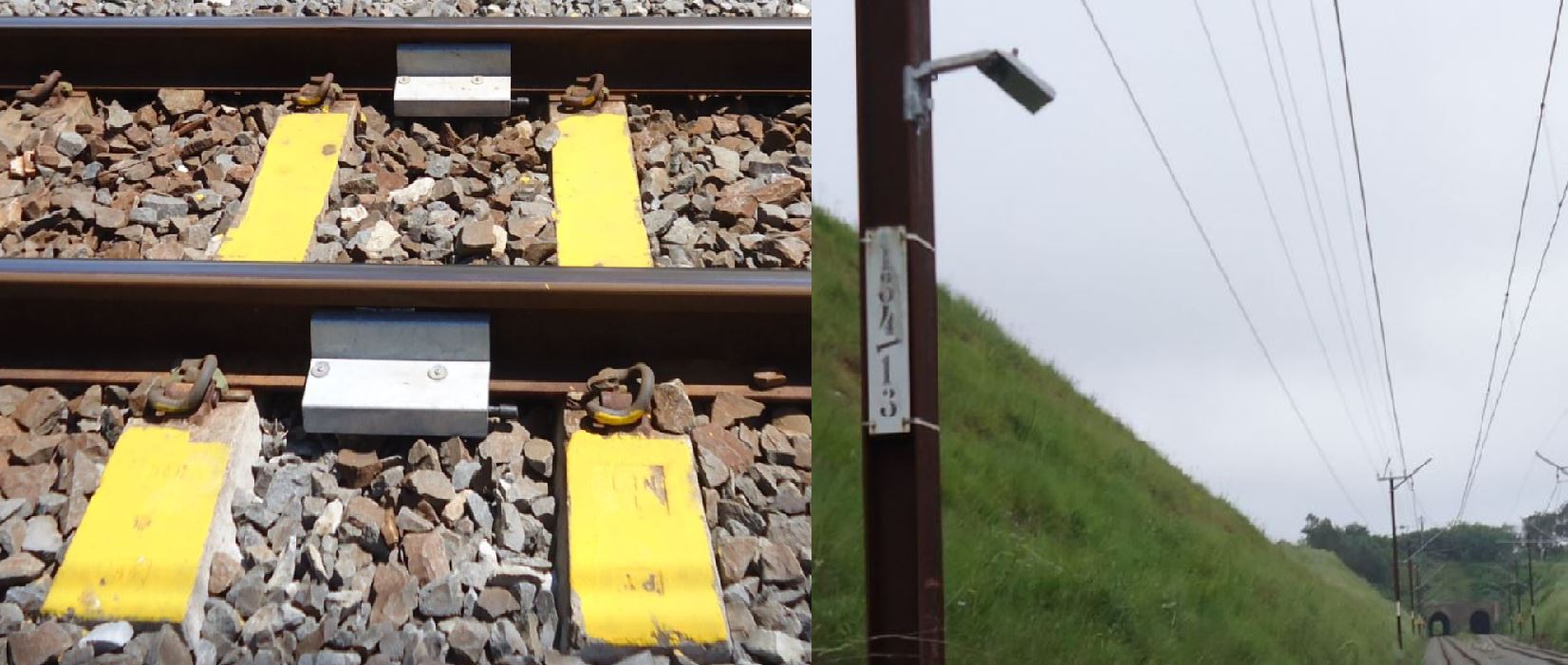
The Continuous Welded Rail Monitor (CWRM) was developed by On-Track Technology against a specification from Transnet Freight Rail (TFR) Technology Management. Using modern strain gauge and microprocessor technology, the system monitors longitudinal forces and temperature in the rail. Measurement nodes are typically installed at a frequency of one per kilometre and at critical areas such as entrances to tunnels or bridges. The use of multiple nodes allows effective management of Continuously Welded Rails (CWR) in order to prevent rail breaks and buckling. CWRM comprises an invaluable contribution to predictive rail maintenance and derailment prevention.
Operational Overview – Wireless System
A CWRM measurement node consists of a Master Processor and up to four Track Nodes, each of which monitors the force and temperature within a rail leg. The Track Nodes report data wirelessly to the Master Processor which in turn relays the information to a back-office server. Communication to the back-office occurs direct via a GSM network or indirectly via a license-free CWRM High Site, which caters for areas with poor GSM coverage.
A virtually unlimited number of these measurement nodes can be added to a CWRM network. These nodes collectively paint a picture of the status of the lines or sections that are monitored, allowing appropriate action to be taken whenever required.
Reporting and Data Options
Access to measured data is provided via three independent means: Web Interface, Scheduled Reporting and Trending Application Interface.
Web Interface – Status View
An interactive Web Interface provides a drill-down view, starting from a top-level view of the line, all the way down to a view of an instrumented site. The interface is based on a series of nodes, which are colour-coded to highlight its status. At top-level, each node represents an entire section of line and as one drills down, the representation becomes more detailed, until finally the representation is of an actual measurement node. At this bottom level, tabulated measurement data is presented alongside the coloured nodes. The graphical approach allows a quick status assessment at a glance, without the need to spend a long time drilling down or studying datasets for each instrumented site. For each site, a full set of plots are available, including Force, Temperature and Stress-Free Temperature vs. Time. From an equipment status perspective, plots of battery and RF levels are also available, as well as communication history.
The colour-coding caters for two distinct user groups: perway and signalling users.
The colours for perway users indicate differing force or stress-free temperature levels within the node, while colours for signalling users highlight the condition of the measurement equipment itself. Each group would view data specific to them, extracting maximum value for their role.
The Web Interface thus provides a good top-level Trending Tool, allowing users to monitor the system at a glance and identify where undesirable conditions may be developing.


Scheduled Reporting
A Scheduled Reporting function periodically distributes exception reports that highlight any areas of concern. Here too, two distinct report families are available: one for perway and one for signals. At the beginning of a shift, each group would typically receive a report where any out-of-range parameter is highlighted on the report. This includes the value of the parameter, the severity of the condition and the location at which the condition was detected.
These reports add another invaluable tool, where management can take place on exception, rather than continually monitoring large datasets.
Trending Application Interface
This interface provides a means of performing more detailed viewing and analysis of the measurement data. Temperature, Force and Stress-Free Temperature, can all be plotted vs. Time. This detailed information can also be exported should the need for further (external) analysis arise.

In a similar way, various diagnostic plots are also available, allowing maintenance staff to monitor the condition and performance of the measurement equipment. Diagnostic plots include parameters such as battery levels, RF signal strength and GSM signal quality.
Product Features and Highlights
Self-Powering
The Master Processor makes use of an integral solar panel and lithium battery to power the Main Processor. A primary cell is used to power the Track Nodes, providing >6 years of operational life, with an 11-year option available.
Modular Design
System nodes are designed to be modular, facilitating a swap out approach. This allows for simple replacement of any major system components. This includes batteries, processors and sensors. Importantly, this ensures a proportional approach to sparing and repairs, rather than a 100% cost implication on any replacement activity. Additionally, in the event that equipment is damaged, a full repair/refurbishment service is available.
Compact Microprocessor-Based System
Both Master Processor and Track Nodes are controlled entirely by dedicated microprocessors making the system energy-efficient and reliable, while providing excellent performance. Each sub-system performs a specific, dedicated task that it is designed to do. The small size of microprocessors and their energy-efficiency results in a compact system that is not easy to spot, hard to damage during track maintenance and vandal resistant. The Master Processor has dimensions 260 x 150 x 35 mm and the Track Nodes 150 x 140mm. Full installation is is easily carried by two people within an hour.
Retrofit Technology
The rail monitoring sensors are retrofitted to the existing rail section. No rail cutting, no sleeper modification or disruption of operations is required. Installation is carried out safely between train movements.
In the event of maintenance activities, such as rail replacement, the track sensors can be safely removed¹ from the track for re-installation on the new track. This ability also allows for relocation of the system and thus ensures the best possible return on equity.
¹Statistically, 25% of sensors may require replacement.

Configuration Options
Each Master Processor can manage up to four rail legs, or two lines. This is a configuration option and the number of monitored rail legs can be increased or decreased at any time. This provides cost benefit as well as a smaller hardware footprint.
Where there is a need for three or more lines to be monitored, additional Master Processors can be installed with no risk of interference between themselves.
Communications Options
The Master Processor utilises the GSM network to report measurement data to the back-office server. Transmitted data is compressed binary data, ensuring a small payload and minimal usage of communication resources.
In cases where GSM signal is poor or unavailable, a High-Site approach is used. In this scenario, up to six Master Processors report to a single CWRM High Site, in a Star Topology. The High Site consists of a slightly modified Master Processor serving as a Gateway to the GSM network – the shared Master Processor platform reduces costs and simplifies stock holding. Communications between the High Site and Master Processors is via a license-free radio with an effective range of up to 40km. This long range virtually ensures that the High Site can be located in an area with adequate GSM coverage.
In cases where distances to GSM coverage are longer than 40km, the High Sites are set up as a number of “hopping” nodes that relay information between themselves. The end node would consist of a GSM High Site, which then relays data to the back-office server.
The various communication options offered ensure data delivery, even for the remotest of sites.
